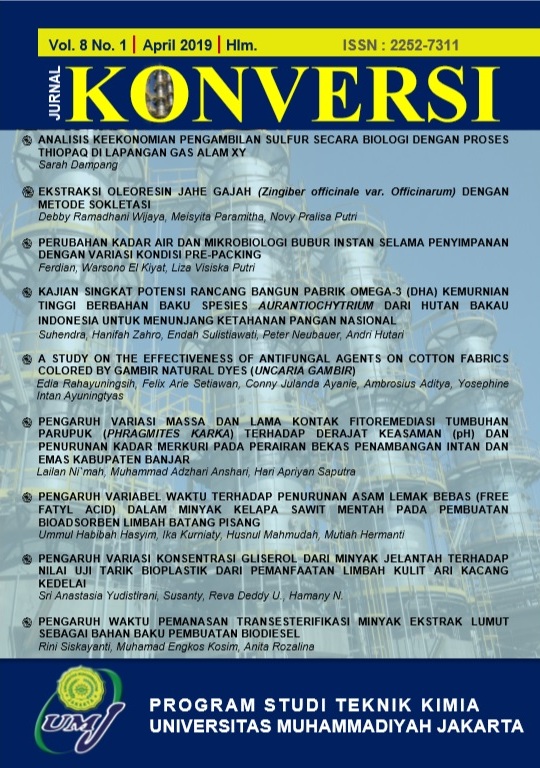A STUDY ON THE EFFECTIVENESS OF ANTIFUNGAL AGENTS ON COTTON FABRICS COLORED BY GAMBIR NATURAL DYES (UNCARIA GAMBIR)
Main Article Content
Abstract
The increasing interest in the use of natural dyes is not accompanied by sufficient information and method for the application due to broad natural dyes resources existence. Gambir (Uncaria gambir), one of promising favorable natural dyes, has been used as batik coloring for decades. However, the application of gambir extract as a textile colorant faces a severe problem to be encountered which is the microbial growth such as fungi, mold, and bacteria. This study proposed several antifungal agents to suppress the growth of the fungus such as chitosan, aloe vera, and formaldehyde. To conduct the fungus inhibition concentration of every antifungal agent, Aspergillus niger was introduced on the colored cloth medium with the addition of Potato Dextrose Broth (PDB) growth media. Three methods of antifungal addition during the coloring process were investigated namely pre-coloring, post-coloring, and mix coloring process. The growth of Aspergillus niger was observed and measured the diameter and thickness of the colony. One-way ANOVA was used to analyze the treatment significantly. The result showed that all concentration of chitosan and formaldehyde addition, significantly, could suppress the fungus growth. However, formaldehyde is a toxic ingredient and harmful to the environment which becomes a limitation in the application. Meanwhile, from the significance level, Aloe vera could not inhibit the Aspergillus niger growth with the addition of 2 and 5 g/L, but it could suppress the Aspergillus niger growth with the addition of 8 g/L. Furthermore, the optimum condition was observed on the addition of 5 g/L chitosan at post-coloring method because of the minimum growth area of the Aspergillus niger.
Article Details
Issue
Section
Articles
Authors who publish with this journal agree to the following terms:
- Authors retain copyright and grant the journal right of first publication with the work simultaneously licensed under a Creative Commons Attribution License that allows others to share the work with an acknowledgement of the work's authorship and initial publication in this journal.
- Authors are able to enter into separate, additional contractual arrangements for the non-exclusive distribution of the journal's published version of the work (e.g., post it to an institutional repository or publish it in a book), with an acknowledgement of its initial publication in this journal.
- Authors are permitted and encouraged to post their work online (e.g., in institutional repositories or on their website) prior to and during the submission process, as it can lead to productive exchanges, as well as earlier and greater citation of published work (See The Effect of Open Access).
